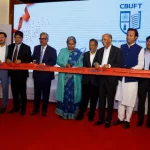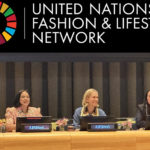Due to fast fashion, the earth is on the verge of a waste revolution – a revolution of waste technology and of systems driven by a revolution in the way people think about waste.
Some people and organizations call this revolution the circular economy. Others prefer the language of regenerative systems. Different models do not matter anymore as waste is rapidly moving from out of sight, out of mind to the center of design, business, media, and education.

The away has moved from a myth to the marketplace, which is to say that waste is no longer “waste,” but instead has been reimagined as a “resource,” an “asset,” a “nutrient,” and an “opportunity.”
Corporate marketing campaigns claim that waste is now “beautiful,” and that waste is no longer a “problem,” rather it is the “solution.” I’ve heard people talk about waste as a “trend to design into” and other people call circularity the “waste-to-gold” revolution.
When so much of the fashion industry runs on a business model that extracts finite resources to produce an infinite amount of stuff, any conversation about recycling waste feels like progress. If we could just turn that stuff back into resources, then everything would be fine—right?
It’s not so simple.
Waste and greed are two sides of the same destructive path. This means that waste cannot be transformed without a better estimate and reconciliation.
I think about and “deal” with clothing waste on a daily basis. Since 2016, my not-for-profit has been working with second-hand clothing retailers and upcycles in Accra’s Kantamanto Market through our project called Dead Man’s White Clothes.
Kantamanto is one of the largest resale and upcycling economies in the world. It is a vibrant, bustling hub of what the Global North now calls sustainability. It is also a mess.
In Kantamanto, 30,000 people work six days a week to sell, repair, clean, and upcycle the Global North’s clothing waste. This should be applauded, but it should not be romanticized. These 30,000 people take on a level of risk that is unjust.
Many of Kantamanto’s retailers take out loans with 35 percent interest rates to purchase the bales of clothing that have been shipped from all over the world; clothing that has, in most cases, been donated for free by consumers or collected by brands as deadstock write-offs.
With only 20 percent of Kantamanto’s retailers making a profit, many refer to their business as a “gambling job.” On top of the steep financial risk associated with this business, the labor is physically backbreaking and spiritually dehumanizing.
And then there is the waste.
Roughly 15 million garments flow through Kantamanto Market on a weekly basis. Kantamanto’s ecosystem of retailers, dyers, printers, cleaners, tailors, and upcyclers re-commodify exponentially more clothing than any “modern,” technology-enabled resale platform in the Global North.
For comparison, ThredUp’s 2020 report states that they have “recirculated” (an unclear term) 100 million items in total and 4 million “fast-fashion” items since ThredUp began as a business in 2009. Kantamanto recirculates (in this case, meaning rehabilitates and resells) 100 million items—the overwhelming majority of them “fast-fashion”—every four months.
But unlike resale platforms like ThredUp, there is no outlet for the clothing that Kantamanto cannot sell. If our clothing lives within a linear economy then Kantamanto is the end of the line.
Not only is there nowhere for unsold clothing to go after Kantamanto, but for Kantamanto retailers, there is nothing even resembling the hundreds of millions of dollars of investment that ThredUp, and similar platforms, have received.
Despite the best efforts of Kantamanto’s entrepreneurs, 40 percent of the clothing leaves the market as waste. Accra lacks the landfill space for this clothing waste, so much of it is burned in the open air, swept into the gutter from where it eventually makes its way to the sea, or dumped in informal settlements where Accra’s most vulnerable citizens live.
I have worked alongside waste pickers clawing through the garbage in hopes of finding valuable materials and I have washed human feces off of clothing recovered from landfill; clothing that was manufactured by some of the world’s largest and most profitable brands and that was sent to Ghana in the name of diversion and circularity.
Waste is not an abstract concept to me and that waste is all the more real for the people who work in Kantamanto day in and day out, playing a game they cannot win.
I remember the first time a brand referred to our research findings as a “goldmine.” It was last April and they were talking about the waste from Kantamanto. Hearing this from one of the largest fashion brands on the planet and from a member of their sustainability team, no less, sent my heart into my gut.
It confirmed the fears that provoked my not-for-profit to launch Dead White Man’s Clothes (and to name our project as such) in 2016, while simultaneously making me wonder if sharing it so publicly would end up doing more harm than good.
This is a company whose leaders hoard wealth gained by exploiting the labor-power of disenfranchised women who work in garment factories. This is a company that has no trouble projecting sales across dozens of different countries and cultures while claiming that a living wage for garment workers is simply incalculable.
A company that uses its massive marketing apparatus to prey on the insecurities of young people, making them believe that consumption will solve their problems. A company that relies on disposability to grow with godlike limitlessness.
For this company (and others since then) to call Kantamanto’s waste stream a “goldmine” isn’t merely absurd. It’s violent.
For our Ghanaian team members, the word “goldmine” stings. It evokes an immediate connection to the Gold Coast Colony – a name given to many diverse West African nations by foreigners. It is a phrase that speaks to the historical exploitation of mineral resources and of human life.
Heard within the word “goldmine” is also the specific ongoing environmental and human cost of small-scale gold mining called Galamsey; the politics of which are entangled with the current neocolonial scramble for Africa.
It is a reminder that little has changed since the recent time of formal colonization. The minds of foreigners are still capable of collapsing all the richness that Ghana represents into an extraction site for foreign benefit.
Make less stuff, move money, and decentralize power. There can be no “sustainable innovation” without justice. Waste will either be the next frontier of colonialism and greenwashing or waste will serve as an opportunity for greater reckoning and reparation. Choose the latter.
(Courtesy: Apparel Insider)






